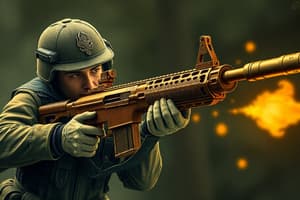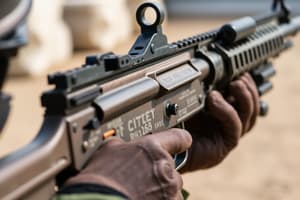Podcast
Questions and Answers
What is the USMC acronym for the Principles of Machine Gun Employment?
What is the USMC acronym for the Principles of Machine Gun Employment?
PICMDEEP
The principles of machine gun employment include Pairs, Interlocking, Coordinating, Mutual Support, Defilade, Enfilading Fire, Economy of Fire, and Protection. Acronym: ___
The principles of machine gun employment include Pairs, Interlocking, Coordinating, Mutual Support, Defilade, Enfilading Fire, Economy of Fire, and Protection. Acronym: ___
PICMDEEP
The Army Principles of Machine Gun Employment can be summarized with the acronym ___
The Army Principles of Machine Gun Employment can be summarized with the acronym ___
MCISSCE
What does MCISSCE stand for in relation to Army Machine Gun Employment Principles?
What does MCISSCE stand for in relation to Army Machine Gun Employment Principles?
What are interlocking fires?
What are interlocking fires?
What does coordination of fires dictate?
What does coordination of fires dictate?
What is defilade?
What is defilade?
What are the characteristics of fire?
What are the characteristics of fire?
Define line of sight.
Define line of sight.
Define trajectory.
Define trajectory.
Define ordinate.
Define ordinate.
Define max ordinate.
Define max ordinate.
Describe the cone of fire.
Describe the cone of fire.
What factors affect a burst of fire?
What factors affect a burst of fire?
Describe the beaten zone.
Describe the beaten zone.
What percentage of rounds is considered an effective beaten zone?
What percentage of rounds is considered an effective beaten zone?
Describe how the length of the beaten zone changes on uniform terrain.
Describe how the length of the beaten zone changes on uniform terrain.
Describe how the length of the beaten zone changes on rising terrain.
Describe how the length of the beaten zone changes on rising terrain.
Describe how the length of the beaten zone changes on falling terrain.
Describe how the length of the beaten zone changes on falling terrain.
What are the three classes of MG fire?
What are the three classes of MG fire?
What are the classifications of MG fires in relation to the ground?
What are the classifications of MG fires in relation to the ground?
In relation to ground, describe dead space.
In relation to ground, describe dead space.
What type of space occurs anytime the target drops below the line of sight?
What type of space occurs anytime the target drops below the line of sight?
In relation to ground, describe danger space.
In relation to ground, describe danger space.
What type of space is 1.8 m above the deck?
What type of space is 1.8 m above the deck?
In relation to ground, describe plunging fire.
In relation to ground, describe plunging fire.
What type of fire is where danger space is confined to the beaten zone?
What type of fire is where danger space is confined to the beaten zone?
In relation to ground, describe grazing fire.
In relation to ground, describe grazing fire.
What type of fire is where the center of the cone of fire does not rise more than 1m off the deck?
What type of fire is where the center of the cone of fire does not rise more than 1m off the deck?
Flashcards are hidden until you start studying
Study Notes
Machine Gun Employment Principles
- USMC acronym for principles of machine gun employment is PICMDEEP, which includes: Pairs, Interlocking, Coordinating, Mutual Support, Defilade, Enfilading Fire, Economy of Fire, and Protection.
- Army principles follow MCISSCE: Mutual Support, Coordination, Interlocking Fire, Sited in Defilade, Sited to produce Enfilade Fire, Cover and Concealment, and Economy of Ammunition.
Fire Coordination and Effectiveness
- Interlocking fires reinforce firepower across unit fronts, ensuring comprehensive coverage without blind spots.
- Coordination of fires mandates appropriate weapon usage on designated targets, optimizing ammunition conservation and ensuring timely delivery of fire.
Tactical Positions
- Defilade allows firing from behind terrain's cover, minimizing exposure to enemy fire and observation.
- Characteristics of fire include trajectory, burst of fire, cone of fire, beaten zone, dead space, and danger space.
Conceptual Definitions
- Line of Sight: An imaginary line from the shooter’s eye through the sights to the target.
- Trajectory: The arching path of a bullet from muzzle to target.
- Ordinate: The height of the bullet's flight path above the line of sight.
- Max Ordinate: The highest elevation of the bullet’s path, reached at two-thirds of the distance to the target.
Fire Patterns and Effects
- Cone of Fire: The pattern of fired rounds influenced by numerous factors, typically 2 mils wide for an M240B.
- Beaten Zone: The elliptical impact area of rounds, consistent in width but terrain-dependent in length.
Range and Terrain Impact
- An effective beaten zone consists of 85% of rounds landing within the target area.
- In uniform terrain, shorter distances yield longer beaten zones, while longer distances reduce zone length.
- Rising terrain affects rounds by abruptly stopping them, creating a small beaten zone. Conversely, descending terrains lengthen the beaten zone.
Classes and Types of MG Fire
- Three classes of MG fire relate to respect for ground, target, and weapon.
- Classifications of MG fires concerning the ground:
- Plunging Fire: Danger space confined to the beaten zone, occurs when firing at varying elevations.
- Grazing Fire: The cone of fire’s center remains within one meter off the ground, considered highly effective.
Space Definitions
- Dead Space: Exists when the target falls below the line of aim or sight.
- Danger Space: Any area up to 1.8 meters above ground is classified as danger space, essential for tactical considerations.
Studying That Suits You
Use AI to generate personalized quizzes and flashcards to suit your learning preferences.




